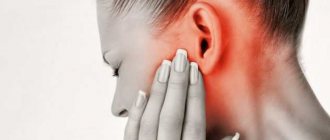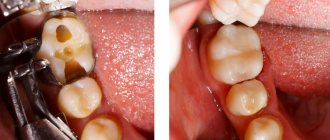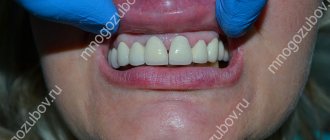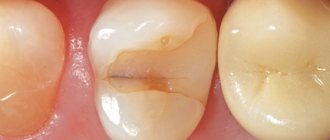Ear pain - mild or intense, shooting or aching - is a symptom that can indicate both a disease of the hearing organ and pathological processes occurring in nearby organs and tissues. According to statistics, otitis media is the most common cause of ear pain. However, the diversity of its forms and many other diseases with similar symptoms require accurate diagnosis and different treatment approaches. To establish the true causes of ear pain, it is necessary to be examined by an otolaryngologist, and sometimes by a neurologist, dentist, and even a cardiologist.
At CELT you can consult an otorhinolaryngologist.
- Initial consultation – 3,000
- Repeated consultation – 2,000
Make an appointment
Otitis externa
Most often, inflammation of the outer ear is bacterial in nature.
The causes of infection may be:
- trauma to the external auditory canal, for example, from a sharp or blunt object, or from a hearing aid;
- skin defects due to eczema, psoriasis, diabetes and other diseases;
- too thorough removal of earwax, which creates an acidic environment that prevents the growth of microbes;
- frequent entry of water into the outer ear (“swimmer’s disease”).
Symptoms of external otitis:
- acute ear pain, aggravated by pressing on the tragus or pulling the earlobe;
- possible itching and a feeling of “stuffiness” in the ear;
- discharge of a purulent or bloody nature, sometimes having an unpleasant odor;
- examination reveals swelling and hyperemia of the external auditory canal;
- possible hearing loss;
- enlargement and tenderness of the lymph nodes in the neck and behind the ear on the affected side.
The course of the disease may be complicated by a perforation of the eardrum, which cannot be determined without a visit to an ENT specialist.
External otitis of fungal origin is a common phenomenon, usually occurring in patients with low immune status or due to long-term use of antibacterial drops. It is characterized by severe itching, the formation of crusts, profuse thick discharge and the absence of a therapeutic effect from the use of antibiotics.
Separately, it is worth noting the localization of a boil on the skin of the external auditory canal or inflammation of the atheroma. The clinical picture is similar to otitis externa, but upon examination there is a more localized focus of inflammation with an opening from which pus and blood can be discharged.
Etiology and pathogenesis
The development of the inflammatory process in the outer ear is preceded by a violation of the integrity of the skin, which can be caused by many reasons - traumatic injuries, prolonged exposure to a humid environment, skin changes due to metabolic disorders, diabetes mellitus, various dermatitis, eczematous processes. Anatomical structural features predispose to the occurrence of external otitis - narrow external auditory canals, the presence of exostoses, as well as wearing a hearing aid, water getting into the ears, insufficient formation and changes in the composition of earwax, impaired local and general immune status, radiation exposure.
According to the literature, 60–98% of inflammatory diseases of the external ear are of a bacterial nature. The microbial landscape of otitis externa has changed over time. If earlier in 70 - 90% of clinical cases Staphylococcus aureus was cultured, and Pseudomonas aeruginosa was present in 10 - 20% of cases, then recently the role of Pseudomonas aeruginosa has increased to an average of 78%, while Staphylococcus aureus is found only in 9 - 27% of cases . Less commonly, in inflammatory diseases of the outer ear, Staphylococcus epidermidis Streptococcus pyogenes, Streptococcus pneumonia, Enterococcus, Escherichia coli, Proteus, Klebsiella pneumonia, Mycoplasma pneumonia, anaerobes and other microorganisms are also detected. In addition to the bacterial flora, pathogenic fungi play a significant role in the development of otitis externa. Most often, fungal infections of the outer ear are caused by molds of the genus Aspergillus and Penicillium and yeast-like genus Candida, less often by fungi of the genus Mucor, Alternaria, Geotrichum, Kladosporiu. In some cases, bacterial or bacterial-fungal associations act as etiotropic factors. Also, otitis externa can be caused by measles, chickenpox, and herpes viruses.
Otitis media
The middle ear communicates with the nasopharynx through the Eustachian tube, through which infection can penetrate from the upper respiratory tract due to acute respiratory viral infections, influenza, sore throat, rhinitis, sinusitis and other diseases. Children are especially often affected because their Eustachian tube is short and wide, which makes it easier for infection to enter. The process can be one- or two-way.
Symptoms of acute otitis media:
- pain in the ear from moderate to severe, pulsating in nature (pain does not depend on pulling the lobe or pressing on the ear canal);
- increased body temperature;
- possible noise in the ear, dizziness, decreased hearing acuity;
- the presence of discharge (mucous, purulent, bloody) indicates a perforation of the eardrum.
With an aggressive course of the inflammatory process and the absence of adequate therapy, otitis media is fraught with such serious complications as meningitis, sepsis, intracranial abscess formation, and deafness.
Classification
According to the course of the disease in otorhinolaryngology, acute (up to 1 month), subacute (from 1 to 3 months), chronic (lasting more than 3 months), and recurrent (3 episodes or more acute external otitis within a year) forms of external otitis are distinguished.
The type of disease is determined by the location and nature of the inflammatory process. Among the nosological forms there are diffuse (eczema, dermatitis, erysipelas, herpes, perichondritis, chondroperichondritis, malignant external otitis and a number of other types and limited external otitis (furuncle, abscess).
According to the degree of severity, there is a mild degree (minor discomfort and itching in the ear, minimal swelling of the skin of the external auditory canal), moderate (pain and itching in the ear, narrowing of the external auditory canal due to severe swelling of the skin), severe (severe pain in the ear, external auditory meatus completely closed, periauricular erythema, regional lymphadenopathy and fever)
Inflammation of the inner ear (labyrinthitis)
The labyrinth is an organ of hearing and balance, is richly innervated and includes auditory and kinetic receptors, so its inflammation causes:
- severe ear pain and headaches;
- a sharp decrease in hearing, the appearance of noise, crackling, squeaking in the ear;
- dizziness, nausea, loss of orientation in space, horizontal nystagmus.
Labyrinthitis occurs as a result of the penetration of infection in various ways from different parts and cavities of the body:
- from the middle ear with untreated or advanced otitis media;
- with infected meninges during meningitis;
- with blood for diseases such as syphilis, tuberculosis, herpes;
- damage to the temporal region, the organ of hearing with disruption of the integrity of cells and blood vessels.
The disease requires immediate medical attention.
Eustachite
Eustachitis is an inflammation of the canal connecting the middle ear to the nasopharynx. The degree of pain varies. Characteristic features are:
- feeling of stuffiness in the ear;
- noise and crackling in the ear, the patient hears his voice as too loud with a weakened perception of extraneous sounds;
- sensation of water pouring into the ear.
In the absence of timely treatment, eustachitis becomes chronic, causing chronic exudative otitis media.
Ear pain
General information
human hearing organ The outer ear includes the pinna, external auditory canal, and eardrum .
The latter is the boundary between the outer and middle ear. The middle ear is located in the temporal bone of the skull and consists of the tympanic cavity, the auditory tube and the mastoid process.
The inner ear is a labyrinth and contains structures, some of which (the semicircular canals) are responsible for the sense of balance, and others (the cochlea) for converting sound vibrations into an impulse, which can then be recognized by the cerebral cortex.
Ear pain
Ear pain can be directly related to the inflammatory process in the ear area or be of a reflex nature in the following diseases :
- acute/chronic tonsillitis;
- sinusitis;
- inflammation of the maxillary joint.
Pain in the ear area can also be caused by pathologies of the jaw, inflammation of the tonsils, sinusitis, but most often – pain in the neck, spine, myofascial pain, as well as neuralgia. Only a medical examination of the ear, head and neck area can reveal the true cause of ear discomfort.
Ear inflammation
Otitis is an inflammation of the ear that can be external (limited, diffuse and moderate). Limited inflammation of the outer ear is more often called furunculosis (inflammation of the sacs and sebaceous glands under the influence of a mechanical factor, manipulation of the ear canal with matches, hairpins against the background of a certain readiness of the macroorganism, reduced immunity in diabetes, gout, hypovitaminosis (A, B, C), as a result of activation or the addition of a staphylococcal infection).
Diffuse inflammation of the external auditory canal is observed mainly in chronic purulent otitis media due to the penetration of various bacteria and fungi into the skin and subcutaneous layer. The inflammatory process often extends to the eardrum. Otitis media occurs:
- spicy;
- chronic;
- purulent;
- catarrhal.
The severity of the inflammatory reaction depends mainly on the virulence of microorganisms and on the state of the protective forces of the macroorganism; in addition, microorganisms activated during viral or bacterial inflammation of the nasal mucosa contribute to the occurrence of an inflammatory reaction such as superinfection, reinfection or autoinfection. The mechanism of penetration of bacterial pathogens can be due to:
- cough;
- sneezing;
- blowing your nose (bacteria enter the middle ear through the auditory tube).
This path, the so-called tubar path, is one of the main ones. Much less often, the infection enters the middle ear through the hematogenous route and, in exceptional cases, through a damaged eardrum. The high virulence of microbes, a decrease in the overall reactivity of the body, and the presence of a chronic pathological process in the nasal cavity and nasopharynx contribute to the transition of acute purulent otitis to the chronic form.
Types of ear pain
Infections in the tonsils, jaws, and sinuses can cause ear pain Types of ear pain depending on the area of the ear :
- The pinna (the part of the ear that picks up sound). Strong winds can cause a painful bruise in the ear area that becomes larger and blue in color. Frostbite or a burn to the ear can cause ear pain or itching.
- Another disease that can cause pain in the area of the ear cartilage is periochondritis (an infection of the skin that protects the cartilage).
- A foreign body lodged in the external auditory canal is the most common cause of ear pain in children.
- Acute inflammation of the external ear. It is often caused by contaminated (bacterial) water entering the ear. The pain is severe and may increase with jaw movement.
- Furunculosis. Infection of the hair follicles in the ear canal. Pain in the ear area is usually very severe and can increase with movement of the jaw and ear. If the tragus (the cartilaginous projection at the front of the outer ear) is compressed, you may feel weak.
Swimmer's ear occurs when the layer of skin in the ear area swells due to dampness, heat and humidity. Frequent contact with water, such as when swimming, softens the skin of the ear canal and makes it more susceptible to infections, especially bacteria. The last stage of swimmer's ear is inflammation of the middle ear . Earwax protects the ear from the external environment. However, sulfur formation can be a problem for many people. In this case, it is necessary to use wax-softening ear drops, and in some cases, consult a doctor to clean your ears by rinsing them with a syringe and remove excess wax. Accumulated wax sometimes causes ear pain or discharge, as well as hearing loss. Itching in the ear area is a fairly common complaint. Itching is caused by dry ear canals and lack of wax. It is often caused by an allergenic fungus. The ear canal is a warm, dark, damp place, which is a good environment for fungus.
Inflammation of the middle ear
Otitis media is a bacterial infection in the middle ear that causes fluid to accumulate in the middle ear. Acute inflammation of the middle ear is the most common reason for visiting a doctor in children. In some children, middle ear inflammation may reoccur. The following symptoms are characteristic of this inflammation:
- pain in the ear area;
- cry;
- pressure in the ears;
- mild fever and agitation.
Secretory inflammation of the middle ear is one of the chronic types of inflammation of the middle ear. It is common in children and is characterized by the formation of thick, sticky fluid in the middle ear that collects behind the eardrum and causes short-term ear pain, a feeling of stuffiness in the ears, and decreased hearing . Pressure in the ear area. It occurs mainly due to blockage of air flow in the eustachian tube, which connects the middle ear to the nasopharynx. Pressure in the ear area is also observed with diseases of the paranasal sinuses. Patients suffering from ear pressure often have allergic rhinitis or sinusitis. Acute mastoiditis is an inflammation of the mastoid cavity in the temporal bone behind the auricle. It is characterized by the following symptoms:
- throbbing pain with weakness and swelling in the cavity of the mastoid bone;
- thick discharge;
- hearing impairment;
- fever;
- weakness.
If you experience the above symptoms, consult your doctor immediately.
Causes of ear pain without hearing loss:
- Acute and subacute inflammation in the external auditory canal without complete blockage of its lumen.
- Arthritis and arthrosis in the jaw joint area.
- Mumps and abscesses of the parotid gland.
- Inflammation (accompanied by an abscess) of congenital parotid cysts.
- Parotid lymphadenitis is inflammation of the lymph node.
In some diseases, pain can radiate to the ear, simulating ear disease :
- Pain due to dental diseases.
- Ulcerative or abscess processes in the area of the angle of the lower jaw, palatine tonsils, pharynx, pyriform sinuses, larynx, as well as the entrance to the esophagus.
- Neuritis and neuralgia of some cranial nerves (glossopharyngeal, vagus and intermediate nerves, auriculotemporal branch of the trigeminal).
Soreness of the auricle and tragus can occur with inflammation of the skin in the ear area, with dermatitis. It is also caused by acute external otitis, including a furuncle of the auditory canal. Perichondritis and chondroperichondritis are inflammation of the cartilage of the auricle. In case of acute pain, we recommend immediately contacting an otolaryngologist. A specialist will be able to conduct professional diagnostics; will prescribe the optimal treatment.
Ear pain of non-infectious origin
Ear tumors
Neoplasms are most often localized in the outer and middle sections; tumors of the labyrinth are an extremely rare phenomenon. Malignant formations of the outer ear are accompanied by severe pain: the pain is burning and radiates to the temple. Possible bleeding; When the ear canal is obstructed, conductive hearing loss develops. If the middle section is affected, the symptoms are similar to otitis media; a high degree of hearing loss and intense pain, increasing in the evening, should alert you. When the process spreads, symptoms of damage to neighboring structures arise: loss of orientation in space, paresis of the facial nerve, trigeminal neuralgia.
Ear injuries
- Mechanical injuries. The auricle most often suffers with the formation of lacerations and damage to cartilage. Blunt trauma to the ear usually results in a hematoma. As a result of trauma to the ear canal, the ear hurts greatly, there is a feeling of stuffiness, and bleeding is possible. Such symptoms are an indication to consult a doctor, since rupture of the eardrum and fractures of the skull bones are possible.
- Barotrauma is caused by a difference in pressure in the external environment and the cavity of the middle ear, for example, during a sharp loud sound (explosion), take-off/landing of an airplane, deep-sea immersion (diving), climbing a mountain. As a result, the eardrum is pulled inward, which is accompanied by pain, noise or ringing, and congestion in the ears. The opposite situation is also possible, when a decrease in atmospheric pressure causes the membrane to bulge outward. As a rule, unpleasant sensations go away on their own, however, if sharp pain is noted, it makes sense to check the integrity of the tympanic membrane when examined by a doctor.
- Entry of a foreign body in the form of small objects or insects causes swelling of the skin of the ear canal, itching, pain, and sometimes hearing loss. Attempting to remove a foreign object yourself can damage the eardrum.
- With burns and frostbite of the ears, **pain // of varying intensity is observed, depending on the degree of damage.
- Conventionally, ear injuries include the formation of wax plugs, which irritate the skin of the ear canal, causing discomfort and tinnitus. Removal should be carried out by an otolaryngologist.
Causes of ear pain
The main factors causing pain in the ear:
- inflammation of the middle or outer ear;
- sulfur plug;
- changes in pressure in the tympanic cavity due to dysfunction of the auditory tube (during flight or diving to depths during diving);
- inflammation of the parotid salivary gland;
- inflammation of the temporomandibular joint;
- neuropathy of the greater auricular nerve and lesser occipital nerve;
- trigeminal neuropathies caused by inflammation of the teeth or paranasal sinuses;
- inflammatory processes in the area of the tonsils and cervical lymph nodes;
- osteochondrosis of the cervical spine, spinal hernia of the cervical spine;
- neoplasms of the neck, parotid region, temporal bone, brain.
The appearance of ear pain can be caused by physical factors:
- traumatic injuries to the structures of the ear and parotid region (rupture of the eardrum, injury to the external auditory canal, temporomandibular joint, fracture of the temporal bone);
- getting contaminated water into the ear while swimming;
- foreign body in the external auditory canal;
- vibrations;
- annoying loud sound (acute trauma);
- temperature changes;
- exposure to UV, X-rays, ionized air.
There are also extra-ear diseases that can cause ear pain. In this case, this pain is radiating - radiating from other surrounding organs and areas of the body. Ear pain can be caused by:
- dental diseases;
- pathologies of the cervical spine;
- diseases of the pharynx (pharyngitis, tonsillitis, tonsillitis);
- tumors of the pharynx, larynx, auditory nerve, parotid gland;
- diseases of the temporomandibular joint;
- sinusitis;
- mumps.
In childhood, ear pain in overwhelming cases indicates a progressive inflammatory process - otitis media. The disease develops against the background of acute respiratory viral infections, rhinitis, sinusitis, as a complication of inflammatory dermatological diseases (psoriasis, eczema), and can appear with infectious pathologies: influenza, measles, scarlet fever, diphtheria. The pain may intensify when chewing, pressing on the tragus, and may be sharp, throbbing, pressing or dull in nature. Along with pain, congestion, ringing, tinnitus, purulent discharge, headaches, fever, and fatigue may occur.
Ear pain due to diseases of other organs
- Mastoiditis - inflammation of the mastoid process - causes intense throbbing pain in the ear, swelling of the tissue behind the auricle, hearing loss, and hyperthermia.
- With arthrosis and arthritis of the temporomandibular joint, the patient is bothered by shooting pains in the ear, which intensify when chewing, a crunching sound in the temple area, and over time, hearing impairment and malocclusion are possible.
- Mumps is an inflammation of the salivary gland located in front of the auricle, accompanied by acute pain in the ear, aggravated by swallowing and chewing, and swelling of the tissues.
- Inflammation of the parotid lymph nodes (lymphadenitis) develops when infection penetrates into them from diseased teeth or from other foci of inflammation.
- Inflammatory diseases of the nasopharynx and sinuses, malignant processes in the larynx and oral cavity are often accompanied by pain in the ear when swallowing.
- Caries, pulpitis. Since the organ of hearing, like the teeth, is innervated by the branches of the trigeminal nerve, damage to the teeth and jaw may be accompanied by pain in the ear area.
- An atypical form of heart attack, when the patient’s only subjective complaint is pain in the ear.
Why does my ear hurt?
Ear pain is most often associated with inflammation of either the outer ear (the pinna and ear canal up to the eardrum) or the middle ear (the cavity of the eardrum just behind the eardrum). In this case, they speak, respectively, of external or otitis media
. If your ear hurts, then most likely the cause is a bacterial or fungal infection in the wound or mouth of the sebaceous gland. Sometimes both the ear and throat hurt at the same time. And this is not surprising: the ear is connected to the nasopharynx and through the auditory tube, the infection can get from the nasopharynx to the middle ear, and then inflammation, causing pain, simultaneously develops in both the throat and ear.
However, ear pain often occurs for other reasons. In children, ear pain is sometimes associated with foreign objects
. If this happens, you should not try to remove the object lodged in the ear yourself - you can damage the eardrum or injure the ear.
Dense earwax plug
may also cause discomfort and pain.
Another possible cause of acute pain is a ruptured eardrum.
.
There are quite common cases when pain felt in the ear indicates a disease in other organs. Doctors call this kind of pain radiating, and people say that the pain “radiates to the ear.”
Similar pain can occur with sinusitis (inflammation of the sinuses), arthritis of the jaw joint, and inflammation of the trigeminal nerve.
For caries of extreme teeth
in an advanced stage, when the nerve or tissue adjacent to the tooth is inflamed, the pain often radiates to the area of the ear, temple and neck. You can recognize the “dental origin” of pain by the fact that it intensifies when you press on the diseased tooth, as well as when eating cold or hot food.
Diagnostics
The diagnosis and treatment of pathologies associated with this symptom is carried out by an ENT doctor (otorhinolaryngologist) or an audiologist (a narrower specialty in otorhinolaryngology). During the appointment, the specialist talks with the patient, examines him, conducts the necessary examination, and establishes a diagnosis.
The multidisciplinary CELT clinic employs experienced, highly qualified otolaryngologists. Rich clinical experience helps them make the correct diagnosis in the most difficult cases.
Treatment
Treatment of inflammatory ear diseases includes:
- antibacterial, antiviral agents of local and general action;
- antipyretics, analgesics;
- physiotherapy;
- in some cases - surgical intervention.
Treatment must be based on accurate diagnosis, which is impossible outside a specialized clinic. The high professionalism of CELT specialists allows us to identify various diseases of the hearing organ and choose the most effective means of solving the problem.
Make an appointment through the application or by calling +7 +7 We work every day:
- Monday—Friday: 8.00—20.00
- Saturday: 8.00–18.00
- Sunday is a day off
The nearest metro and MCC stations to the clinic:
- Highway of Enthusiasts or Perovo
- Partisan
- Enthusiast Highway
Driving directions










